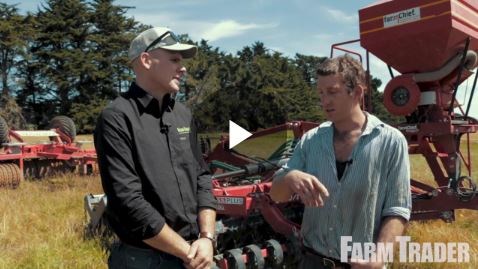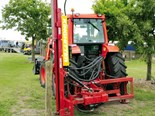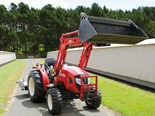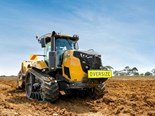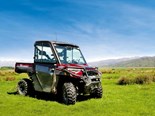Test: Farmchief express seed discs
Just like the three-piece road train itself, it has three times the benefit for the farm – a dream result
One of the reasons I love my Farm Trader role is the opportunity to discover places that you would otherwise never know existed.
.jpg)
This time, I scored an in-depth look at Willesden Farms Ltd, 20 minutes east of Christchurch. Although it has something of a ‘middle of nowhere’ feel about it, relatively speaking, compared to a lot of large southern properties, it’s actually well located near a major city.
The reason for the visit was to catch up with Nick Murdoch who runs the cropping programme on the farm, alongside the overall farm manager. In the past two years, they’ve completely changed their cultivation programme.
 |
|
The Farmchief Express Seed Discs sowing a crop of forage brassicas
|
Two reasons are behind the change. Firstly, they needed to speed up the job. Given the amount of area they were trying to cover during a year, reducing man and tractor hours was the main goal.
Secondly, they are in an environmentally sensitive area with the majority of the cultivated land on the Kaitorete Spit, which is a thin parcel of land between Lake Ellesmere and the sea, so it requires some specialist treatment.
Out with the old, in with the new
 |
|
The impressive set-up at work
|
Willesden Farms weighs in at a hefty 5500 hectares. Of that, 1200 hectares is flat and the 600 hectares is irrigated, with roughly 400 hectares cropped each year. The farm employs eight staff and Nick has been with the business for nine years, originally starting out as a shepherd.
These days, he enjoys the flexibility of doing the cropping programme and spending some time in the tractor, although, he still loves getting out and working with the cattle.
There’s a variety of soil types to contend with, from sandy silt loam in the lower country down by the lake to heavy marine clay on the lakefront, and then up the valley, heavy silt clay loam prone to water logging in winter, which is particularly hard on gear given that it makes up the majority of the flat country. The main reason behind getting away from traditional heavy cultivation was to reduce the compaction of heavy cattle in winter.
Given the fine soils and often rocky subsoil, ploughing or working five to six inches on the top is simply not an option, as you bury what precious topsoil you have and don’t want cattle up to their bellies in mud during winter. Clearly, a rethink and change of strategy was required.
The Willseden Farms team now do all the groundwork, just leaving the precision planting and harvesting to contractors. However, they do have an additional direct drill that allows them to have a diverse mix of crops, such as lucerne, kale, maize, pasja, rape, annual ryegrass/oats, fodder beet, as well as some speciality crops such as clovers, radishes, and pak choi.
One-pass operation
 |
|
The one-pass transformation is obvious
|
After looking around, the decision was made to go with the FarmChief 4.5m Express Speed Discs. As the name suggests, these have a 4.5-metre working width with 36 560mm discs spread over two rows.
With an overall weight of 4.5 tonnes (excluding the seed hopper), this gives a down pressure of 120kg per disc. While the discs are rubber mounted to offer contour following, there’s no cut angle adjustment that could be beneficial for the variety of soil conditions on the farm.
 |
|
Easy access to the 800L hopper
|
The reason behind opting for this machine is to allow a one-pass operation, where both primary and secondary cultivation can be done. Hooked up behind a 230hp tractor, they aim to do as few passes as possible.
Ideally, with a little more tractor horsepower, the impressive road train would operate at optimum efficiency, which I reckon is about 14km/hr.
Anything over this creates a bouncing effect on the machine, which results in waving across the paddock, so between 11 and 14km/hr is perfect for a smart paddock finish.
The other reason for opting for this type of machine is the ability to achieve everything in just one pass, particularly for speciality crops that are often planted in late August.
 |
|
A bird’s eye-view of the discs, levelling paddles, heavy tines, and roller
|
Sometimes, heavy cultivation equipment can be detrimental to the soil structure, so loosening with the rippers and then one-pass cultivating and seeding has benefited the farm, both in output, crop yield and soil health.
The sequence used is:
- Rippers
- Hydraulic paddles
- Two rows of discs
- Heavy tines
- Ribbed heavy rubber roller
- (ideal for stoney conditions)
- Seeding outlets
- Chain harrows
- Rear folding Cambridge roller
The combination works with a set of auto-reset rippers at the front. These obviously subsoil, breaking up any pans. Then the paddles on front of the speed discs carry a bit of soil to sort humps and hollows. Two sets of 560mm discs are mounted on an angle and followed by the set of heavy-duty tines.
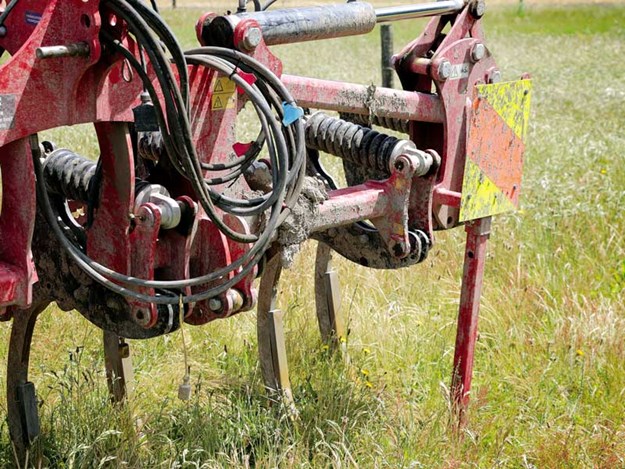 |
|
The 4m auto reset rippers
|
This creates a scattering effect of the soil, which allows the seed to be blown on. The rubber roller compacts and smooths the seedbed, and a set of chain harrows follow to give the seeds soil coverage. This ensures good seed to soil contact before finally being rolled with the Cambridge roller with rear breaker rings.
There are some paddocks that do get ripped first. If winter pugging or historical pan issues need sorting, then the rippers are hooked onto the road train and the one pass process begins.
Nick has learnt that there are a couple of little tricks with hooking this on, as the rear linkage hooks on the back of the ripper must attach to the two-point linkage on the express discs. It all sounds simple enough, but they need to be high enough above the ground because obviously you can’t back up and dig the rippers into the ground and hook the three-point linkage up at the same time.
Pushing the discs all the way down and lifting the rear packer roller up lifts the front of the express discs. This is Nick’s life hack and will definitely help re-attach the rest of the cultivation equipment once the ripping has been done.
 |
|
The complex hydraulics system
|
The second potential complication is that obviously there’s a lot going on hydraulically. The tractor has four spools: one for the rippers for folding, the second for the drill seeder fan, the third controls the rear Cambridge roller, and the fourth is for the discs with a changeover valve, allowing four different options to be done from the one spool.
These are: discs up and down, paddles up and down, wings folding, and transport wheels up and down. This doesn’t allow on the move adjustment of the paddles or headland lifting, so Nick is looking to adjust the hydraulic set-up to allow this, so he won’t need to change spools each time he moves to a different paddock.
The business end of the seeding operation is done from the 800-litre hopper. This has three different seed rollers, which are easy to take out depending on crop being sown.
Eight seed outlets reach to the rear while calibration is easily done from the outside via a prime button and weigh sack.
The weight is then punched into the computer, which works out the desired seeding rate and you’re good to go. Good access and a safe loading platform with a high handrail rounds out the specs on the Swedish-built seeder unit.
Verdict
 |
|
A bird’s eye-view of the discs, levelling paddles, heavy tines, and roller
|
The speed discs are successful in this sort of country due to the fact the first discs throw the soil straight up. Then, by the time it comes down, it hits the second set of discs, which throw it up again.
During this process, as the stones in the soil are heavier, they drop down first. This means they drop down in front of the double roller, so by default, you’re bringing soil to the surface, burying the stones and giving the seed a really nice seedbed.
Combined with the fact the machines can cover the ground quickly with one pass, and you have an instant reduction in tractor and man hours, enabling more efficiency and the ability to get more crops in the ground when the weather conditions are right.
 |
|
Two rows of offset discs
|
There’s a tenfold reduction in compaction already and given you can shallow the discs right up to 1½ to 2 inches, you’re not dictated on depth by turning sod over like a plough or offset discs.
This makes a big difference on finer clay soils to crop establishment, yield, and subsequent cattle grazing. Just like the three-piece road train itself, it has three times the benefit for the farm – a dream result.
Pluses
- One-pass machine reducing both tractor and man hours
- Sealed disc bearings reduce greasing time
- Primary cultivation and secondary in one
- Airseeder offers great flexibility given the variety of crops sown
- Paddles offer great levelling meaning nice level paddock finish
- Given the work rate and quality soil finish, this machine allows more area to be covered during favourable weather windows
- Given most of the topsoil disturbance is only two inches deep, a massive reduction in compaction by heavy cattle in the winter has been observed.
Minuses
- Chains that cover the seed can get caught by the wheels and bend the spreader bar
- No angle adjustment on the discs
See more disc ploughs for sale in NZ.
Watch the Farmchief express seed discs in action
Keep up to date in the industry by signing up to Farm Trader's free newsletter or liking us on Facebook

